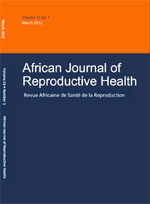
|
African Journal of Reproductive Health
Women's Health and Action Research Centre
ISSN: 1118-4841
Vol. 6, No. 1, 2002, pp. 41-49
|
 Bioline Code: rh02008
Bioline Code: rh02008
Full paper language: English
Document type: Research Article
Document available free of charge
|
|
|
African Journal of Reproductive Health, Vol. 6, No. 1, 2002, pp. 41-49
| fr |
La Nature de la Psychose Puepérale à l'Hôpital National de Muhumbili: Co-morbidité, Obstétrique Principale et Facteurs Sociaux
Noah K Ndosi and MLW Mtawali
Résumé
Quatre-vingts malades hospitalisés atteints de la psychose puerpérale six semaines après l'accouchement ont été enquêtées à l'Hôpital National de Muhimbili pendant deux ans. Pour le diagnostic, on s'est servi de l'histoire psychiatrique formelle, l'évaluation de l'état mental, les critères de la recherche et du diagnostic y compris ICD 10 ainsi que la progression clinique. Nous avons établi les caractéristiques socio-démographiques, les désordres physiques concomitants, les principaux évenements obstétriques, le début de la psychose puerpérale après l'accouchement ainsi que le soutien social donné à l'aide d'un questionnaire structuré. L'âge moyen était 23,6 ans; la plupart des femmes étaient des primpares ayant une parité d'entre un et trois enfants. Les principales co-morbidités physiques comprennent l'anémie chez 51,4% des cas, les infections chez 44,2% et la gestose-EPH chez 17,4%. La plupart des mères ont reçu le soutien social de la part de leurs familles étendues. On a découvert que 4/5 souffraient de la psychose organique et que 8,1% étaient atteintes de la schizophrénie. On a découvert également qu'il y a un taux élevé du commencement de la psychose puerpérale (3,2/1000 naissances) surtout chez les jeunes femmes primpares. (Rev Afr Santé Reprod 2002; 6[1]: 41-49)
|
| |
| en |
The Nature of Puerperal Psychosis at Muhimbili National Hospital: Its Physical Co-Morbidity, Associated Main Obstetric and Social Factors
Noah K Ndosi and MLW Mtawali
Abstract
Eighty six in-patients suffering from puerperal psychosis within six weeks after childbirth were prospectively investigated in Muhimbili National Hospital during two years. Formal psychiatric history, mental status evaluation, research and diagnostic criteria including ICD 10 and clinical progression were employed for diagnosis. Using a structured questionnaire, the socio-demographic characteristics, concomitant physical disorders, major obstetric events, period of onset of puerperal psychosis following delivery and social support given were established. Mean age was found to be 23.6 years; the majority was primiparous women with parity of between one and three children. Main physical co-morbidities included anaemia in 51.4% of cases, infections in 44.2% and EPH-gestosis in 17.4%. Most mothers received social support from their extended families. Organic psychosis was found in four fifths of the mothers and schizophrenia in 8.1%. A high rate of early onset puerperal psychosis (3.2/1000 births), predominantly in young primiparous women, was found. (Afr J Reprod Health 2002; 6[1]: 41-49)
Keywords
The nature of puerperal psychosis Muhimbili National Hospital
|
| |
© Copyright 2002 - Women's Health and Action Research Centre
Alternative site location: http://www.ajrh.info
|
|
